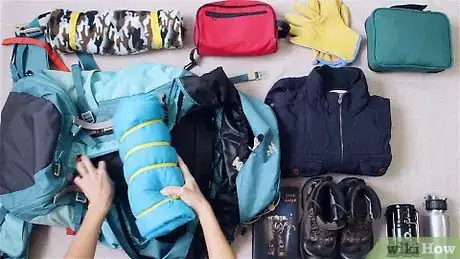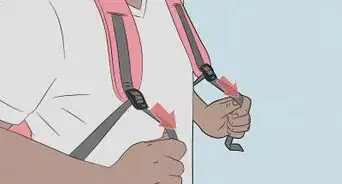This article was co-authored by Tiffany Jumaily, MD. Dr. Tiffany Jumaily is a Board Certified Pediatrician and a fellow of the American Academy of Pediatrics (FAAP) based in Los Angeles, California. With over a decade of experience in the medical field, Dr. Jumaily specializes in identifying the root cause of symptoms and presenting manifestations of disease. She holds a BA in Biology from Boston University and an MD from Boston University School of Medicine. Her dedication to combining evidence-based allopathic medicine with complementary and alternative therapies has led to her being featured and cited in various platforms including U.S. News & World Report, Forbes, and CBS Los Angeles.
There are 11 references cited in this article, which can be found at the bottom of the page.
This article has been viewed 16,442 times.
Whether you’re hiking, going to school, or just trying to move something important, backpacks are invaluable. However, dealing with all the straps and belt buckles can be a little trickier than you expect. Hiking backpacks have the most adjustable straps, but even smaller work and school bags have some of the same features. With proper adjustments, you can carry a backpack for longer with minimal strain on your neck and back.
Steps
Putting on a Backpack
-
1Pack the backpack before attempting to adjust it. The weight distribution in the pack makes a big difference in how the pack fits your body. Place lighter gear at the bottom, such as a sleeping bag, clothing, or light books. Place heavier gear on top of it, in the backpack’s center, and closer to your body. You can then place the lightest gear on top.[1]
- If you’re testing a backpack’s fit, at least fill it with some weight. A lighter backpack feels much different than a full one, and you won’t be able to adjust it accurately until you actually put it to use.
- If you’re going on a trip, wait to adjust the backpack until you have finished packing it. When you’re wearing it, check the weight distribution to ensure it isn’t throwing you off-balance.
-
2Loosen all straps on the backpack. Disconnect any buckles that will get in your way, such as the ones on the hip and sternum straps. Then, to loosen the straps, find the buckles on each one. Pull each strap back through the buckles until you’re able to squeeze underneath the backpack’s shoulder pads.[2]
- For example, the shoulder straps will have buckles near the bottom of the shoulder pads. Pick up the tail ends of the straps and move them back toward the top part of the backpack.
Advertisement -
3Fit the backpack over your shoulders. Lift it to slip your head between the shoulder pads. It won’t fit perfectly at this point, but it doesn’t have to. Just make sure it feels comfortable on your body and not too heavy.[3]
- A good backpack will be the same length as your torso. It should span from the base of your neck to your waist. If yours is the wrong size, it may be uncomfortable even after you finish adjusting it.
- Check the backpack’s weight distribution as well. If you feel it pulling you backward, rearranging or removing some stuff may help.
- Remember—you want the backpack to be a bit high up on your back.
-
4Position the straps on your shoulders and waist. Move the shoulder pads between your neck and shoulders. They should be spaced the same distance from your neck and wrap comfortably around the tops of your shoulders. Fit the waist belt near your hips. Make sure all of the other straps are accessible near your sides.[4]
- Both shoulder pads are meant to be used on all backpacks, including shoulder backpacks. If you only use one pad, the backpack’s won’t be well-balanced and it will put a lot of strain on your neck and back.
Connecting a Waist Belt
-
1Place the waist belt padding on top of your hips. Grab onto the ends of the waist belt at the bottom of the backpack. Pull both ends forward so they are in front of your stomach. Before securing the belt, raise it as needed so it rests comfortably over your hips.[5]
- The pads won’t close together. Instead, they will end above your legs, leaving a gap between them.
-
2Snap the buckle halves together to secure the belt. The buckle halves are on the ends of the waist belt. Pull both halves toward the center of your body to join them together. Keep the buckle in front of your body. It won’t be very tight yet, but it should still be centered over your stomach.[6]
- Let the belt buckle hang off of your waist until you finish tightening the strap. If it isn’t below your waist before then, check the belt’s positioning to make sure it is correct.
-
3Tighten the waist belt by pulling the strap ends. Use the loose straps hanging from the buckle halves. Pull them away from the buckle at the same time so the belt tightens evenly. Continue pulling the belt tighter until it rests lightly against your abs. It shouldn't press against your body or otherwise limit your range of motion.[7]
- Make sure the belt isn’t pinching you. If it feels too tight, feed the straps back through the buckles.
- To fit the waist belt properly, try shrugging your shoulders. Tighten the belt while your shoulders are up. When you lower them, the belt will drop down as well to rest over your hips.
Securing Shoulder Straps
-
1Pull the shoulder straps down until they are flat against your body. Look along the bottom edge of each shoulder pad for a loose strap. Grab onto the straps and pull them straight down at the same time. Lowering the pads this way tightens them at the same time. Pull them down until they are about level with your armpits.[8]
- The shoulder straps should still feel comfortable, so loosen them if they pinch your back or shoulders. Push the straps back through the buckles to release some of the pressure.
- If your backpack is the right size for your body, the straps will follow the shape of your shoulders. Get a different backpack size if you notice space between the padding and your shoulders.
-
2Move the load lifter straps over your shoulders. The load lifter straps are on the top part of the backpack, which will be behind your head. Take one in each hand and gently pull them forward at the same time. Position them on top of the shoulder straps.[9]
- Test the straps by taking a few steps forward. If you feel yourself being pulled back by the backpack’s weight, the straps may not be tight enough.
-
3Adjust the load lifter straps until the backpack is tight against your body. Check your balance after adjusting the straps. If you feel like the backpack is pulling you backward, then the load lifter straps may not be tight enough. Make them so the top part of the backpack is vertical, parallel with your head. To loosen the straps, push them back through the buckles.[10]
- As a rule of thumb, the load lifters form a 45-degree angle with the top of your shoulders. It isn’t easy to see while you’re wearing the backpack, so use a mirror or have someone else check it for you.
Fitting a Sternum Strap
-
1Pull the sternum strap across your chest. The final strap is the one right below your neckline. Look for the loose ends of the strap hanging from the shoulder pads. Pull them towards one another at the same time. Keep the strap about 1 in (2.5 cm) below your collarbone.[11]
- Note how pulling the sternum strap relieves some of the pressure from the shoulder strap. If the straps feel too tight against your body, go back and loosen the shoulder straps first.
-
2Snap the belt buckle halves together to secure the strap. Each end of the sternum strap will have half of the buckle. After fitting them together, rest the buckle flat against your body. Position the strap along the top part of your chest with the buckle in the center.[12]
- Make sure the buckle is well-secured and out of the way of your arms. Try swinging your arms a few times to test if the strap restricts your range of motion.
- If the strap feels restrictive, undo the belt buckle. Check that is it positioned below your collarbone, but not as low as your armpits.
-
3Pull the strap tight until the backpack rests against your shoulders. The sternum strap pulls the shoulder pads closer together. As you pull the tail end of the strap toward one side, it will relieve some of the pressure on your body. Make sure the strap is well-secured but not able to constrict your movement or breathing. If you need to, loosen it by feeding the strap back through the buckle.[13]
- If you feel a little uncomfortable at this point, you can go back to the shoulder straps and loosen them a little further. The sternum strap affects the shoulder straps a little bit, so you may have to make further adjustments to them.
- Always do the sternum strap last. Even though you may feel tempted to take care of them when tightening the shoulder straps, you won’t get the best possible fit that way.
Expert Q&A
-
QuestionHow do you wear a school backpack safely?
 Tiffany Jumaily, MDDr. Tiffany Jumaily is a Board Certified Pediatrician and a fellow of the American Academy of Pediatrics (FAAP) based in Los Angeles, California. With over a decade of experience in the medical field, Dr. Jumaily specializes in identifying the root cause of symptoms and presenting manifestations of disease. She holds a BA in Biology from Boston University and an MD from Boston University School of Medicine. Her dedication to combining evidence-based allopathic medicine with complementary and alternative therapies has led to her being featured and cited in various platforms including U.S. News & World Report, Forbes, and CBS Los Angeles.
Tiffany Jumaily, MDDr. Tiffany Jumaily is a Board Certified Pediatrician and a fellow of the American Academy of Pediatrics (FAAP) based in Los Angeles, California. With over a decade of experience in the medical field, Dr. Jumaily specializes in identifying the root cause of symptoms and presenting manifestations of disease. She holds a BA in Biology from Boston University and an MD from Boston University School of Medicine. Her dedication to combining evidence-based allopathic medicine with complementary and alternative therapies has led to her being featured and cited in various platforms including U.S. News & World Report, Forbes, and CBS Los Angeles.
Board Certified Pediatrician Make sure that the weight is manageable! The backpack should be something that's comfortable for you to lift, so you aren't carrying around excessive weight all day. Also, be sure to take frequent breaks, and give yourself an opportunity to put your backpack down and/or carry your books in your arms.
Make sure that the weight is manageable! The backpack should be something that's comfortable for you to lift, so you aren't carrying around excessive weight all day. Also, be sure to take frequent breaks, and give yourself an opportunity to put your backpack down and/or carry your books in your arms.
Warnings
- If you use a backpack that doesn’t fit you well, it puts stress on your neck and back. This can lead to long-term problems like pain and poor posture.⧼thumbs_response⧽
- Even the best hiking backpacks cannot support more than 20% of your body weight, and it’s 10% for school backpacks. If you need to carry more weight at one time, use another alternative, such as a rolling backpack, for safety.[16]⧼thumbs_response⧽
References
- ↑ https://www.youtube.com/watch?v=LQC7DeOhjHg&feature=youtu.be&t=166
- ↑ https://www.outsideonline.com/2312101/how-properly-fit-your-backpack
- ↑ https://highwaywalkersblog.weebly.com/blog/how-to-adjust-a-backpack-to-your-body
- ↑ https://highwaywalkersblog.weebly.com/blog/how-to-adjust-a-backpack-to-your-body
- ↑ https://besthiking.net/how-to-fit-backpack/
- ↑ https://www.youtube.com/watch?v=0SGiGZlppMM&feature=youtu.be&t=150
- ↑ https://www.youtube.com/watch?v=t7KOsgJrSmI&feature=youtu.be&t=46
- ↑ https://www.outsideonline.com/2312101/how-properly-fit-your-backpack
- ↑ https://highwaywalkersblog.weebly.com/blog/how-to-adjust-a-backpack-to-your-body
- ↑ https://www.youtube.com/watch?v=Y3mgubLL9wE&feature=youtu.be&t=59
- ↑ https://besthiking.net/how-to-fit-backpack/
- ↑ https://www.youtube.com/watch?v=X258hs7HHaw&feature=youtu.be&t=55
- ↑ https://www.youtube.com/watch?v=0SGiGZlppMM&feature=youtu.be&t=202
- ↑ https://www.outsideonline.com/2407833/veterans-elite-thru-hiking-squad
- ↑ https://uihc.org/health-topics/your-backpack-too-heavy
- ↑ https://uihc.org/health-topics/your-backpack-too-heavy




























































